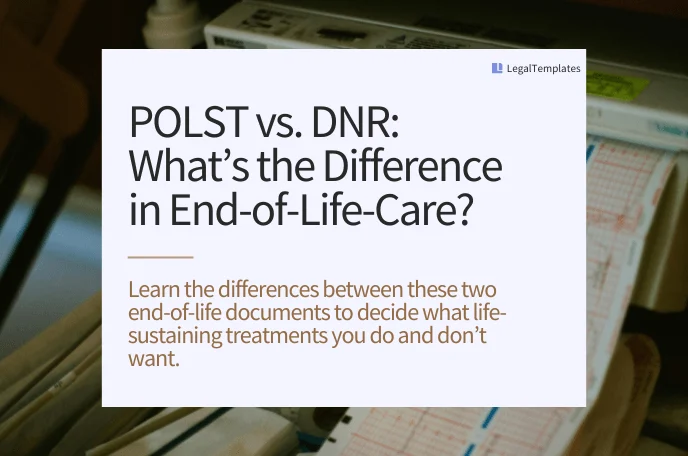
If you have a serious illness or a poor prognosis for an existing medical issue, you may start thinking about what degree of life-saving interventions you want in case your condition escalates. While contemplating these matters can be emotionally challenging and upsetting, it’s essential to address them so medical providers and health care facilities can honor your preferences.
You can dictate your medical treatment preferences with various documents, including a POLST form and a DNR order. While both documents allow people with grave health conditions to dictate their preferences for emergency medical services, they have notable differences.
Read on to explore the differences between a POLST and a DNR order so you can have an informed conversation with your doctor about your desired medical treatment and end-of-life care.
What Is a POLST Form?
A Physician Order for Life-Sustaining Treatment (POLST) form is a medical document dictating specific instructions for caring for a patient experiencing a medical crisis.
Unlike a valid health care directive that provides instructions for future health care, a POLST dictates immediate medical instructions and orders for life-sustaining treatment that health care professionals should follow in emergencies.
Examples of life-sustaining treatment that a POLST might specify to administer or withhold include cardiopulmonary resuscitation (CPR), intubation, and mechanical ventilation.
What Is a DNR Order?
A Do-Not-Resuscitate (DNR) order is a medical document that tells emergency medical personnel not to perform resuscitation efforts, such as CPR, if a patient experiences cardiac or respiratory arrest. This document is more narrow in scope than a POLST, as it only addresses situations when a patient stops breathing or their heart stops beating.
A DNR order doesn’t address non-resuscitative treatments or other aspects of health care, such as comfort care or pain management. A patient would have to fill out a different document, such as POLST or advance directive, to dictate their preferences for treatment in other instances.
POLST vs. DNR: Key Differences
Here are the key differences between a POLST and a DNR in terms of several factors:
| Factor | POLST | DNR |
|---|---|---|
| Purpose | Provides detailed instructions about various medical interventions and treatments. | Specifically instructs medical care providers not to perform resuscitation efforts like CPR if cardiac or respiratory arrest occurs. |
| Type of Care Covered | • CPR • Mechanical ventilation • Intubation • Artificial hydration or nutrition • Dialysis • Antibiotics and other medical | • CPR only (including rescue breaths, chest compressions, and defibrillation) |
| Who Completes It | The patient (or their representative) completes it in consultation with their physician. | The patient (or their representative) completes it in consultation with their physician. |
| Applicability | Typically for individuals with serious illnesses or near the end of life. | Typically for patients who wish to avoid resuscitation in case of cardiac or respiratory arrest. |
| Medical or Legal Status | Is a medical and legal document. | Is a medical and legal document. |
| Scope of Instructions | Broader. | More specific. |
| Activation | Activated based on the specific medical conditions and treatment preferences outlined. | Activated when a patient experiences cardiac or respiratory arrest. |
| Flexibility | Allows for specific instructions regarding various medical interventions. | Allows for less flexibility because of its focus on a lack of resuscitation. |
| Legal Requirements | Each state has a POLST program with specific requirements to follow. | Must be signed by the patient and some combination of their physician, witnesses, and a notary public. See state-specific requirements. |
How to Make a POLST Form or DNR Order
The processes for creating a POLST form and a DNR order are similar, but you must follow the appropriate requirements for your jurisdiction. Here are the general steps to follow:
1. Understand the Purpose of Your Chosen Document
Review the above directions to understand the purpose of your chosen document. As a summary, you can remember that a POLST form provides broader instructions for life-sustaining treatments in an emergency. Alternatively, a DNR order requests that emergency personnel refrain from performing CPR if a patient’s heart stops or they stop breathing.
2. Schedule a Doctor’s Appointment
Once familiar with each document, you can schedule an appointment with your doctor. At this appointment, they can further clarify anything about these documents that still might be unclear. They can also consult with you to help you understand how your choices align with your medical condition.
Bring Any Relevant Medical Records
Doctors will often review a patient’s medical records to help them make an informed decision. For example, suppose a patient is showing signs of recovery. Or, recent test results may indicate that their condition isn’t as grave as medical providers originally suspected. In this case, physicians may advise against a DNR order.
3. Review the Form and the Instructions
Procure the form you’d like to complete. Review it thoroughly, whether it’s a POLST form or a DNR order. Follow any accompanying instructions. Ensure you understand what each section means and how your choices will impact your medical care.
4. Complete the Form
Complete the form with your physician’s assistance. Ensure that you fill out all sections according to your preferences. The final form should clearly reflect your preferences regarding medical treatments and interventions.
5. Sign and Date
Sign and date the completed form. Obtain your health care provider’s signature as well. Review the signing requirements in your area to ensure you acquire all other signatures, like those of a witness or notary public, if needed.
Can Someone Besides a Physician Sign My POLST Form or DNR Order?
In most cases, a physician will have to sign your POLST form or DNR order. However, some jurisdictions may accept the signature of a nurse practitioner or other approved health care professional, especially if the professional works in collaboration with or under the supervision or agreement of a physician.
6. Distribute It
Provide copies of your POLST form or DNR order to your primary care physician and any specialists you see. You can also distribute it to other relevant health care facilities. Include the document in your medical records and ensure it’s easily accessible in case of an emergency.
Plan Your End-of-Life Care Now
You can implement various measures to guarantee your end-of-life care goes according to your wishes. Individuals can establish a medical power of attorney so someone can make decisions on their behalf. Alternatively, they can write a living will (health care directive) to dictate their preferences for future end-of-life care.
However, these documents aren’t always readily available in an emergency. That’s where DNR orders and POLST forms come into play. By setting up these emergency documents, patients can share their wishes ahead of an unforeseen emergency.
Frequently Asked Questions
Can family members overrule a DNR?
In most cases, family members cannot overrule a DNR. A patient writes and executes a DNR (once they obtain the proper signatures) so it follows their wishes. Therefore, an external party can’t override the patient’s preferences.
Family members can discuss their concerns with the patient’s health care team, but they should respect the patient’s wishes.
Does a DNR mean no treatment?
No. A DNR only specifies a patient’s refusal to accept resuscitation efforts if they experience cardiac or respiratory arrest. It doesn’t mean that the patient will receive no other medical treatments. Medical teams can still issue non-resuscitative treatments, comfort care, and pain management treatments according to the patient’s needs and preferences.
How often should I update my POLST?
You should update your POLST every time there’s a significant change in your health status or treatment preferences. You can also update it if you relocate to a new health care setting. Discuss desired changes with your doctor to ensure they correspond to your current condition.
What makes a DNR order or a POLST form invalid?
A DNR or POLST may be invalid if one of the following conditions is true:
- The form is incomplete or lacks essential information.
- The form is missing signatures from the patient, their authorized individual, or the physician.
- The form is outdated and doesn’t correspond with the patient’s current wishes.
- The form doesn’t comply with local or state regulations.
- The form doesn’t comply with the health care facility’s policies.
- The form was completed fraudulently or contains unauthorized changes.
